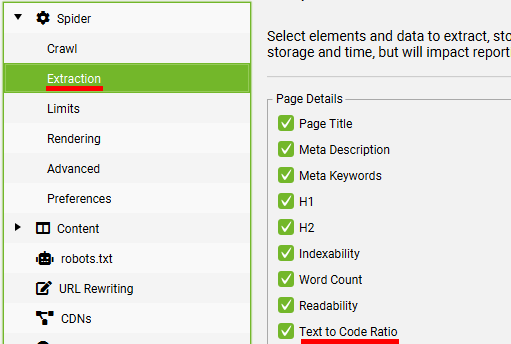Screaming Frog is a staple tool in the arsenal of SEO professionals. This platform provides a wealth of page metrics that can be utilized in diverse ways. Among these metrics is the "Text Ratio," which offers insights into the textual content of web pages. Understanding and harnessing this metric can significantly contribute to content analysis and optimization strategies. Learn more about addressing key technical SEO challenges to improve your site's performance.
In this article, we delve into the definition of Text Ratio, its significance, and practical applications for evaluating content quality.
Screaming Frog’s Definition of Text Ratio Metric
Screaming Frog defines Text Ratio as the number of non-HTML characters in the HTML body tag divided by the total number of characters on the page, expressed as a percentage. To utilize this metric effectively, ensure it is enabled in Screaming Frog's settings to generate comprehensive reports during website crawls:

Practical Applications
Here are a couple of ways to use the Text Ratio metric.
Evaluating Pages Within a Site
Suppose your website utilizes templates for pages, such as product pages on e-commerce platforms like Shopify or Bigcommerce. By crawling these pages and examining their Text Ratios, you can identify variations in textual content depth.
Pages with higher Text Ratios indicate richer textual content, suggesting more detailed product descriptions or informative content.
Use Text Ratio rankings to prioritize content optimization efforts, focusing on pages with lower Text Ratios to enhance content depth and relevance.
Comparing Against Competitor Pages
Analyze how your page's Text Ratio compares to competitors targeting the same keywords. This approach provides insights into content competitiveness and potential areas for improvement.
By benchmarking your Text Ratio against top-ranking competitors in Google search results, you can assess the effectiveness of your content strategy.
For example, comparing Text Ratios among top-ranking pages for the keyword "malus toringo" (a type of a tree) revealed interesting trends, with higher-ranking pages exhibiting higher Text Ratios on average (7.43%) compared to lower-ranking ones (3.15%).
Coincidence? Why don’t you run the same test for your target keywords and see if there is a correlation between my results and yours?
Final Thought
The Text Ratio metric offered by Screaming Frog serves as a valuable tool for content analysis and optimization in the realm of SEO. By understanding the significance of Text Ratio and implementing strategies to leverage this metric, we can enhance content quality, improve website performance, and increase visibility in search engine results.
Incorporating Text Ratio analysis into your SEO toolkit enables data-driven decision-making and fosters continuous improvement in content strategy and execution.
Connect with us if you need help optimizing your website.



















 We Are Slicedbread.
We Are Slicedbread.